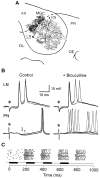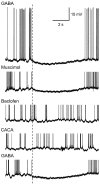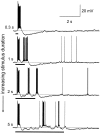Multitasking in the olfactory system: context-dependent responses to odors reveal dual GABA-regulated coding mechanisms in single olfactory projection neurons
- PMID: 9671685
- PMCID: PMC6793051
- DOI: 10.1523/JNEUROSCI.18-15-05999.1998
Multitasking in the olfactory system: context-dependent responses to odors reveal dual GABA-regulated coding mechanisms in single olfactory projection neurons
Abstract
Studies of olfaction have focused mainly on neural processing of information about the chemistry of odors, but olfactory stimuli have other properties that also affect central responses and thus influence behavior. In moths, continuous and intermittent stimulation with the same odor evokes two distinct flight behaviors, but the neural basis of this differential response is unknown. Here we show that certain projection neurons (PNs) in the primary olfactory center in the brain give context-dependent responses to a specific odor blend, and these responses are shaped in several ways by a bicuculline-sensitive GABA receptor. Pharmacological dissection of PN responses reveals that bicuculline blocks GABAA-type receptors/chloride channels in PNs, and that these receptors play a critical role in shaping the responses of these glomerular output neurons. The firing patterns of PNs are not odor-specific but are strongly modulated by the temporal pattern of the odor stimulus. Brief repetitive odor pulses evoke fast inhibitory potentials, followed by discrete bursts of action potentials that are phase-locked to the pulses. In contrast, the response to a single prolonged stimulus with the same odor is a series of slow oscillations underlying irregular firing. Bicuculline disrupts the timing of both types of responses, suggesting that GABAA-like receptors underlie both coding mechanisms. These results suggest that glomerular output neurons could use more than one coding scheme to represent a single olfactory stimulus. Moreover, these context-dependent odor responses encode information about both the chemical composition and the temporal pattern of the odor signal. Together with behavioral evidence, these findings suggest that context-dependent odor responses evoke different perceptions in the brain that provide the animal with important information about the spatiotemporal variations that occur in natural odor plumes.
Figures








Similar articles
-
GABAergic mechanisms that shape the temporal response to odors in moth olfactory projection neurons.Ann N Y Acad Sci. 1998 Nov 30;855:475-81. doi: 10.1111/j.1749-6632.1998.tb10608.x. Ann N Y Acad Sci. 1998. PMID: 9929641 Review.
-
Contrast enhancement of stimulus intermittency in a primary olfactory network and its behavioral significance.J Biol. 2009;8(2):21. doi: 10.1186/jbiol120. Epub 2009 Feb 20. J Biol. 2009. PMID: 19232128 Free PMC article.
-
Role of GABAergic inhibition in shaping odor-evoked spatiotemporal patterns in the Drosophila antennal lobe.J Neurosci. 2005 Oct 5;25(40):9069-79. doi: 10.1523/JNEUROSCI.2070-05.2005. J Neurosci. 2005. PMID: 16207866 Free PMC article.
-
Multi-unit recordings reveal context-dependent modulation of synchrony in odor-specific neural ensembles.Nat Neurosci. 2000 Sep;3(9):927-31. doi: 10.1038/78840. Nat Neurosci. 2000. PMID: 10966624
-
Performance of a Computational Model of the Mammalian Olfactory System.In: Persaud KC, Marco S, Gutiérrez-Gálvez A, editors. Neuromorphic Olfaction. Boca Raton (FL): CRC Press/Taylor & Francis; 2013. Chapter 6. In: Persaud KC, Marco S, Gutiérrez-Gálvez A, editors. Neuromorphic Olfaction. Boca Raton (FL): CRC Press/Taylor & Francis; 2013. Chapter 6. PMID: 26042330 Free Books & Documents. Review.
Cited by
-
Insect-machine hybrid system for understanding and evaluating sensory-motor control by sex pheromone in Bombyx mori.J Comp Physiol A Neuroethol Sens Neural Behav Physiol. 2013 Nov;199(11):1037-52. doi: 10.1007/s00359-013-0832-8. Epub 2013 Jun 8. J Comp Physiol A Neuroethol Sens Neural Behav Physiol. 2013. PMID: 23749329 Review.
-
Two types of local interneurons are distinguished by morphology, intrinsic membrane properties, and functional connectivity in the moth antennal lobe.J Neurophysiol. 2015 Nov;114(5):3002-13. doi: 10.1152/jn.00050.2015. Epub 2015 Sep 16. J Neurophysiol. 2015. PMID: 26378200 Free PMC article.
-
Properties of external plexiform layer interneurons in mouse olfactory bulb slices.Neuroscience. 2005;133(3):819-29. doi: 10.1016/j.neuroscience.2005.03.008. Neuroscience. 2005. PMID: 15896912 Free PMC article.
-
Modeling the cellular mechanisms and olfactory input underlying the triphasic response of moth pheromone-sensitive projection neurons.PLoS One. 2015 May 11;10(5):e0126305. doi: 10.1371/journal.pone.0126305. eCollection 2015. PLoS One. 2015. PMID: 25962173 Free PMC article.
-
Neural correlates of behavior in the moth Manduca sexta in response to complex odors.Proc Natl Acad Sci U S A. 2009 Nov 17;106(46):19219-26. doi: 10.1073/pnas.0910592106. Epub 2009 Nov 11. Proc Natl Acad Sci U S A. 2009. PMID: 19907000 Free PMC article.
References
-
- Adrian ED. The electrical activity of the mammalian olfactory bulb. Electroencephalogr Clin Neurophysiol. 1950;2:377–388. - PubMed
-
- Axel R. The molecular logic of smell. Sci Am. 1995;273:154–159. - PubMed
-
- Baker TC, Haynes KF. Field and laboratory electroantennographic measurements of pheromone plume structure correlated with oriental fruit moth behaviour. Physiol Entomol. 1989;14:1–12.
Publication types
MeSH terms
Substances
Grants and funding
LinkOut - more resources
Full Text Sources
